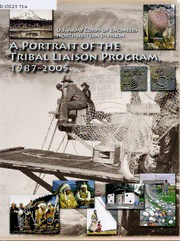
A portrait of the Tribal Liaison Program, 1987-2005 /U.S. Army Corps of Engineers, Northwestern Division ; introduction by Lisa Mighetto ; oral interviews by Lisa Mighetto and Heather Lee Miller. PDF
Preview A portrait of the Tribal Liaison Program, 1987-2005 /U.S. Army Corps of Engineers, Northwestern Division ; introduction by Lisa Mighetto ; oral interviews by Lisa Mighetto and Heather Lee Miller.
D 103.2:T 73/4 ^ ^27u- - 4jBf&ft mKEF — jfet f • lis^ •« .:-i&gSt'aEi 'wty i JMiiJWr H I to.' W^ P^!!l«l r , 'T^MPNM Wk W ^ Digitized by the Internet Archive in 2016 with funding from University of Florida, George A. Smathers Libraries https://archive.org/details/portraitoftribalOOomah A PORTRAIT OF THE PROCRAM TRIBAL LIAISON 1987 2005 - Army Corps of Engineers U.S. Northwestern Division INTRODUCTION BY MICHETTO LISA ORAL INTERVIEWS BY LISA MICHETTO AND HEATHER LEE MILLER Foreword v Preface vii Introduction ix Interview 1 Ismael Caballero, Bill Mellick, Kimberly Oldham, Mary Lee Johns, Georgeie Reynolds, and Lynda Walker 1 Interview 2 Colonel Richard W. Hobernicht (retired) 39 Interview3 Jennifer Richman 51 Interview 4 Chip Smith 65 Interview 5 Colonel Mark Tillotson (retired) 85 Interview 6 David Vader 101 Interview 7 Pern Hall 117 Acronyms 135 Index 136 It is with great pleasure that we introduce A Portrait ofthe Tribal Liaison Program 1987 - 2005 for the U.S. Army Corps of Engineers, Northwestern Division. The program has evolved slowly while enduring many set-backs, changes of policy, and shifting political climates. Throughout the history of the U. S. Army Corps of Engineers in the Northwestern Division, there have been individuals who supported and championed the development and maintenance of good relationships with the sovereign Indian nations. In the mid-1990s, the climate was right for a long-overdue change to an emphasis on executing management decisions that could be concurrently legally, morally, and ethically correct. The movement toward this atmosphere has been a slow and difficult one. The oral interviews presented here reflect many facets of the liaison program. During the period of time for these interviews, it was the Native American Program. The interviews are decidedly personal glimpses, reminiscences of people, places, and events and may contain differences of memory and interpretation, but the reader will be able to understand the program through the stories and experiences of the individual tribal liaisons. We would like to express our heartfelt gratitude to the district and division commanders as well as the tribal leaders who provided support and direction for the program. The Northwestern Division has come a long way, and much remains to be accomplished towards the final goals. Interaction and communication with sovereign nations needs to become an ingrained habit, needing no regulations, rules, policy, guidelines, or reminders for proper and effective consultation. In the final analysis, a successful program is one that inculcates honesty, respect, and provides comprehensive education for all it touches, encouraging both Corps officials and tribal members to "walk in both worlds." Those liaisons in divisions and districts and other dedicated individuals will remain steadfast and pursue these goals of the program. As said by a tribal member in the mid-1990s, the liaison(s) "stand strong and proud in their actions to improve and enhance the interactions with the tribal governments. We know it is not an easy way of life for you, but the actions are appreciated by both the tribal governments, the individual tribal members, and the Creator." We hope this portrait will intrigue and educate the reader. Most of all, we hope that positive change continues in the Northwestern Division and subsequently across the Corps of Engineers. Direlle R. Calica Lynda L. Walker NWD NWD Liaison Liaison 2005 to present 1995 thru 2004 V The Northwestern Division and Portland District of the U.S. Army Corps of Engineers contracted with Historical Research Associates, Inc. (HRA) in 2004 to prepare A Portrait ofthe Tribal Liaison Program 1987- 2005 by recording oral interviews with Corps liaisons. Included here are the transcripts of the oral interviews and a brief introduction of the overall events and changes in policies that brought about the creation of the liaison program. HRA historians consulted with Vickie Tomberlin, Information Management, and Lynda Walker, Native American Coordinator, in identifying individuals to be interviewed. Interviewee selection was based on availability as well as familiarity with the program. There are many persons who were referenced, and not interviewed due to situational and time constraints, that remain equally talented and served as catalysts to growth of the division. The division acknowledges those current and former Northwestern Division tribal liaison appointees at Northwestern Division Headquarters and the five district locations for their input offering a balance ofbusiness and personal information. The division would like to thank Mr. Charles Smith, Assistant for Environment, Tribal and Regulatory Affairs - Office of theAssistant Secretary of the Army (Civil Works), and Dr. Georgeie Reynolds, U. S. Army Corps of Engineers Tribal Liaison Program, Headquarters, Washington, DC for participating in the project. The division would also like to thank Dr. John Lonnquest, Office of History, for reviewing the history. The division ends with acknowledgements to Ms. Carol Hastings, graphic designer of the Portland District Visual Information Branch, for providing invaluable assistance with the design, layout, and production of this publication. All photographs, maps, and illustrations used in this book are from the U. S. Army Corps of Engineers unless otherwise credited. Vickie Tomberlin Records Manager, Northwestern Division VI
